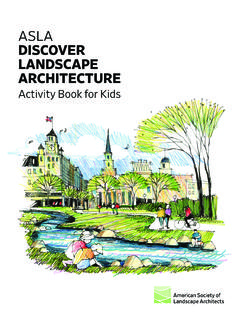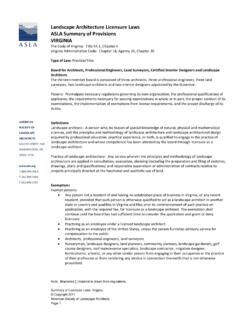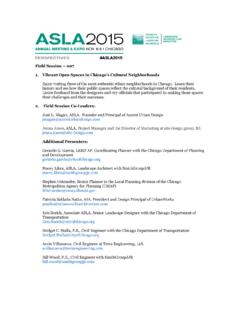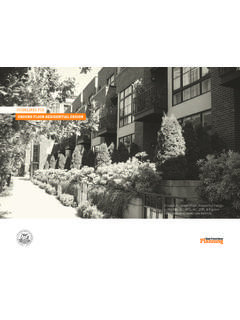Transcription of DESIGNING WITH THE HOMELESS | INTRODUCTION
1 DESIGNING with THE HOMELESS | INTRODUCTION . Instructional Level: Intermediate Primary Topic: Homelessness Secondary Topic: Social and Environmental Justice How can landscape architects, planners and designers be a force for positive change in addressing homelessness? How can we engage HOMELESS populations as clients in a participatory design process? According to HUD's July 2010 5th HOMELESS Assessment Report to Congress, in a single night in January 2010, there were 649,917 people experiencing homelessness in America. This is equivalent to a city the size of Seattle, Washington, or Memphis, Tennessee. In New York City alone, it is estimated that 36,000 people are HOMELESS on any given night.
2 In 2003, children under the age of 18 accounted for 39% of the HOMELESS population; 42% of these children were under the age of five. This same study found that unaccompanied minors comprised 5% of the urban HOMELESS population. However, in other cities and especially in rural areas, the numbers of children experiencing homelessness are much higher. In 2004, 25% of HOMELESS were ages 25 to 34; the same study found percentages of HOMELESS persons aged 55 to 64 at 6%. Most studies show that single HOMELESS adults are more likely to be male than female. The number of HOMELESS families with children has increased significantly over the past decade.
3 Families with children are among the fastest growing segments of the HOMELESS population. Families with children comprised 23% of the HOMELESS population. These proportions are likely to be higher in rural areas. Research indicates that families, single mothers, and children make up the largest group of people who are HOMELESS in rural areas. These populations represent not only tremendous human suffering but also a tremendous loss of human potential. Some city leaders react to the issue by issuing bus fares to remove the HOMELESS from their urban boundaries, simply transferring the problem to other jurisdictions. Some choose to embrace the challenge by seeking to provide housing and health care for their HOMELESS citizens.
4 How do landscape architects address the design of sites that contain HOMELESS populations? What responsibility do landscape architects have to address the needs of HOMELESS populations? How can the actions of landscape architects positively impact the health, well-being, and future prospects of these 650,000 Americans? LEARNING OBJECTIVES HOMELESSNESS: Homelessness is the condition of people without a regular dwelling. People who are HOMELESS are most often unable to acquire and 1) Understand the causes of homelessness and the magnitude of the issue in maintain regular, safe, secure, and adequate housing, or lack fixed, regular, and America.
5 Adequate night-time residence. The term HOMELESS may also include people whose primary night-time residence is in a HOMELESS shelter, a warming center, 2) Understand the challenges of daily life for a HOMELESS person. a domestic violence shelter, a vehicle, cardboard boxes, a tent, tarpaulins, or 3) Understand how city policies including zoning, affordable housing, social other ad hoc housing situations. services and policing, can impact the well-being of HOMELESS populations. SOCIAL JUSTICE: The belief that every individual and group is entitled to fair and equal rights and participation in social, educational, and economic 4) Understand how landscape architects have addressed the needs of the opportunities.
6 Social justice addresses an agenda for increasing understanding HOMELESS through design . of oppression and inequality and taking action to overcome them. 5) Learn effective techniques for engaging the HOMELESS population in ENVIRONMENTAL JUSTICE: Addresses issues of 1. unequal distribution of resources participatory design . such as clean air and water, healthy food, homes, parks, places to walk and sit in public, etc.; 2. inaccessibility to public goods and resources because of 6) Understand how designers can help forge reciprocal partnerships between transportation, cost or discrimination; and 3. exclusion from facilities and full park users and stakeholders, HOMELESS advocates, affordable housing participation in decisions about one's community largely because of poverty, prejudice, race, income, recent immigration, or other marginal status.
7 Landscape advocates, social services advocates and others. architects increase or diminish environmental injustices by nearly every act of 7) Understand how design can help the HOMELESS toward self-sufficiency. planning and design , either knowingly or unwittingly. Environmental justice may be considered a subset of social justice in that it is place-based. DESIGNING with THE HOMELESS | TAKE ACTION. What role can design play in addressing the needs of the HOMELESS ? ACTIONS AND STRATEGIES FOR LANDSCAPE ARCHITECTS. 1) Take initiative to understand the many conditions surrounding homelessness. Factors include domestic violence and abusive households, drug and alcohol addictions, shortage of affordable housing, inadequate health care services and untreated mental illness.
8 2) Be an advocate for local municipalities and non-profits who offer services such as clinics, job centers and training, subsidized permanent housing and temporary housing. Support youth and veteran's out-reach programs that offer pathways to employment, counseling, health services, and affordable housing and education. 3) Understand the many points of view of HOMELESS individuals relative to shelter, safety and use of public space. Understand that they may not seemingly have a stake to hold, but may be a primary user of public open space who determine the success or failure of those spaces. HOMELESS individuals are not going away until American housing policy provides adequate places for people to live.
9 4) design public spaces with HOMELESS persons as a user group. design matters, both the process and products of public space, in accommodating their needs and the needs of other users, from spatial allocation and benches to sleep on to places for basic hygiene. Advocate for more public restrooms in our parks and rights-of-way. 5) Learn that HOMELESS individuals are not all the same. Their situation varies from person to person, from group to group, from community to community. In each place, ask them directly to tell us their needs so we can begin to develop categories of spatial and policy need. 6) Seek out HOMELESS individuals: go where they are and try to walk in their shoes.
10 Like most Americans at the margins of society, few are likely to attend formal workshops or public hearings. Be creatively humanistic, engaging on their turf. Work and/or volunteer at the local level in your own community by visiting a shelter or public open space. Meet the individuals, look them in the eye and listen between the lines. Ask if they are willing to share their stories and challenges. Be short on pity and long on respect. 7) Create forums for HOMELESS individuals to advocate for themselves at every scale from park and shelter design to local and federal housing policy. Provide settings for conflicting parties to negotiate face-to-face.


















